Trapezius Palsy
Table of Contents
What is Trapezius Palsy?
- Trapezius muscle palsy occurs when there was damage to the nerve that controls or maintains the trapezius muscle causing it to waste or become weak. Trapezius palsy is a rare nerve condition in the shoulder that causes pain or weakness. It includes injury to the spinal accessory nerve at the neck and shoulder. The spinal accessory nerve travels from the neck to the trapezius muscle. The nerve might be stretched as the result of a direct blow to the shoulder and neck or from a fall on the shoulder with the neck bent toward the opposite side of the shoulder. It may also occur from minor surgeries on the neck. Injury to the spinal accessory nerve results in weakness of the trapezius muscle, which assists with shoulder blade (scapula) function; injury causes the scapula to pull further from the chest wall with attempted shoulder movement, known as scapular winging. The scapula is the base from which the shoulder muscle functions. With winging, the shoulder works off a weak base, making the shoulder function weak or painful.
Anatomy of Trapezius Muscle
- The trapezius muscle is a large, triangular, paired muscle situated on the posterior aspect of the neck & thorax. When viewed combined, these pairs create a diamond or trapezoid shape, what its name says. The trapezius has many joining points, extending from the skull & vertebral column to the shoulder joint girdle.
Origin of the trapezius muscle
The trapezius muscle has different starting points along the midline of the posterior neck and back.
- The superior fibers join to the medial third of the superior nuchal line & the external occipital protuberance of the occipital bone. These fibers have a descending course near their ending point, hence why this part of the trapezius is termed the descending part.
- The middle fibers start from the nuchal ligament, which is joined to the spinous processes of the C1 to C6 vertebrae, as well as the spinous processes of C7 to T3 vertebrae & their intervening supraspinous ligaments. These fibers are directed horizontally and run laterally near the shoulder. Thus, these fibers present the transverse part of the trapezius.
- The inferior fibers arise from the spinous processes of the T4 to T12 vertebrae & their respective supraspinous ligaments. These fibers course superiorly & laterally towards their ending point & hence presents the ascending part of the trapezius.
Insertion of the trapezius muscle
- Together with their course, all fibers of the trapezius diverge laterally on the superior angle of the scapula to join to their respective ending points.
- The superior fibers end on the posterior border of the lateral 3rd of the clavicle.
- The middle fibers end in the medial margin of the acromion of the scapula, as well as in the superior crest of the scapular spine.
- The inferior fibers end through aponeurosis on a tubercule at the external apex of the medial end of the scapular spine.
Nerve Supply
- The trapezius muscle is the only muscle of the upper limb that does not collect its nerve supply from the brachial plexus. Instead, the motor nerve supply to the trapezius is transmitted by the accessory nerve (CN 11) as well as the anterior rami of the C3 & C4 spinal nerves, which also include proprioceptive/sensory fibers from the muscle.
Blood Supply
The vascular supply to the trapezius varies depending on the level.
- The descending (upper) part of the muscle is conveyed by transverse muscular branches starting from the occipital artery (branch of the external carotid), which crosses along the deeper surface of the muscle.
- The transverse (middle) part of the muscle is transmitted by the superficial cervical artery, or by a branch from the transverse cervical artery.
- The ascending (lower) part is transmitted by muscular branches of the dorsal scapular artery, which starts from the subclavian artery.
The action of the trapezius muscle
- Descending part: it raises the pectoral girdle
- Middle part: it works to retract the scapula
- Ascending part: it works to depress shoulders
- Descending & ascending together: it helps the rotates scapula upside
- Bilateral contraction: it works to extend the neck
- Unilateral contraction:
- It works for Ipsilateral side flexion of the neck
- Middle part: it helps with ipsilateral side flexion & contralateral axial rotation of the upper thoracic area
The function of the Trapezius Muscle
- The trapezius muscle is active, together with the deltoid muscle & the rotator cuff muscles. In addition, the trapezius is also included in the movements of the head & neck.
- The motion of the trapezius muscle is broadly dependent on the direction of the fibers that are squeezing.
Descending (upper) fibers
- Synonyms: Flexio lateralis cervicis
- The descending (upper) fibers work with the levator scapulae muscle to generate an elevation of the scapula at the scapulothoracic joint. In the same manner, they also engage the level of the shoulders against gravity e.g. when weight is being held in the hand.
- When the muscle is working unilaterally, the descending fibers create an ipsilateral lateral flexion of the head & neck by working on the atlanto-occipital joint & upper cervical vertebrae, respectively. Unilateral contraction might also result in opposite side rotation of the head at the atlantoaxial joint. Bilateral contraction of the descending part of the trapezius (i.e. when both right & left muscles contract) causes an extension of the head & neck.
Ascending (lower) fibers
- The ascending (lower) fibers are done for the depression of the medial part of the scapula, thus lowering the shoulder. This action work is especially necessary for activities in which the shoulders are lower down against resistance, for example when using the hands to assist ownself up from a seated position.
- Combined with the descending part, the ascending fibers also create a rotation of the scapula around an axis that passes anteroposteriorly via the base of the scapular spine.
Transverse (middle) fibers
- The transverse (middle) fibers work combine with the rhomboids to create a retraction of the scapula, by pulling it towards the midline. The trapezius muscle is also used for the upward rotation of the scapula, together with the serratus anterior muscle. This allows us to raise our arms above our heads above the level of the shoulder.
Causes Of Trapezius Palsy
- The cause of trapezius muscle palsy is damage to the Spinal Accessory Nerve, which controls and manages the trapezius muscle.
- Damage to this nerve might be caused by:
- A jerking injury of the arm
- Trauma to the neck
- A jerking injury of the neck
- A result of surgery to the neck
Signs and Symptoms Of Trapezius Palsy
- Signs and Symptoms of trapezius muscle injury might include:
- Pain or discomfort, usually burning and the dull ache that is poorly localized, often in the back of the shoulder and shoulder blade
- Heaviness and fatigue of the arm
- Difficulty in raising the arm above shoulder level
- Loss of power of the shoulder muscles
- Pain in the back while sitting on a chair with a high back, a result of the scapula hitting or touching the back of the chair
- A bump in the back of the shoulder at the scapula that is more prominent when trying to reach to the side and overhead
- Atrophy (shrinkage) of the trapezius muscle, causes the neckline to look asymmetric
- Visible trapezius wasting
- Drooping of the shoulder
- Some pain in the trapezius muscle
- Shoulder visibly lower than the opposite side shoulder
- Muscle weakness, especially when shrugging shoulders or raising shoulder blades and arms
- Decreased range of movement at the shoulder joint
Complications of Trapezius Palsy
- Permanent weakness of the shoulder, especially in lifting power or when working with the arm overhead activity
- Stiffness of the shoulder joint
- Persistent pain in the shoulder joint
- Increasing weakness in the extremity
- Disability or inability to compete
Risk Factors
- Poor physical conditioning (strength, flexibility)
- Contact sports
- Surgery around the neck
Preventive measures
- Appropriately warm up or stretch before practice or competition.
- Maintain proper conditioning that includes shoulder flexibility, muscle strength, or endurance training.
- Wear proper shoulder protective pads.
Medical Treatment
Medication
- Nonsteroidal anti-inflammatory medications, such as aspirin or ibuprofen (do not take for seven days before surgery), and other over-the-counter pain relievers, such Safran M, Zachazewski J, Stone D: Instructions for Sports Medicine Patients, 2nd Edition 1223 as acetaminophen, are generically recommended. Take these as directed by the physician, or contact the doctor immediately if any bleeding, stomach upset, or signs of an allergic reaction occur.
- Stronger pain relievers might be prescribed by the physician, commonly only after surgery. Use these only as directed, or take only as much as you need or require.
Physiotherapy Treatment for Trapezius Palsy
Physiotherapy can be very effective in treating trapezius muscle palsy. Treatment is aimed at reestablishment the function of the trapezius muscle. Physiotherapy treatment can include:
- Electrotherapy
- Stretching exercises
- Strengthening exercises
- The practice of functional movements
Electrotherapy for Trapezitis
TENS (Transcutaneous Electrical Nerve Stimulation)
- One of the most commonly used electrotherapy devices is used for pain decrease. Small or sticky pads with electrodes are put over and near the area where a person senses pain. The physiotherapist will decide the surface of the placement of electrodes. A series of low-voltage electrical currents are transmitted by the battery-operated unit to the area. You will be raised and decreased the electrical current as well as the frequency or the patterns of stimulation by using the controller.
LASER (Light Amplification by Stimulated Emission of Radiation
- LASER Therapy is very much useful in Trapezitis to reduce inflammation and pain from the trapezius muscle.
- Electrical Stimulation is used to regenerate the power and strength in the palsy of the trapezius muscle. Initially to regenerate the power of the muscle IG (Inter Galvanic) stimulation was given. At a later stage, once the activation of the trapezius muscle is achieved the SF (Surge Faradic) stimulation was given.
- Shoulders back and down and maintain this position
- Place towel between elbow and side
- Slowly rotate the hand down from the abdomen
- Hold 3 sec. Repeat 12-15 times
Heat and Cold Compressors
- Cold is used to relieve pain or reduce inflammation in acute or chronic cases. It should be applied for 10 to 15 mins every two to three hours as needed or immediately after any activity that aggravates the symptoms. Use ice packs and an ice massage.
- Heat might be used before performing stretching or strengthening activities prescribed by the physician, physical therapist, and athletic trainer.
- Use a heat pack and a warm soak.
Using Self-Massage Techniques
Knead each side of the neck by using the opposite hand.
- Cross the left arm in front of the chest to bring the hand up to the right shoulder. With a kneading motion, rub the muscle back of the shoulder, much like kneading dough. Bring the arm slowly down the right shoulder, kneading as you go. Give enough pressure that you can feel it, but not so much that it hurts. Repeat the process on the opposite side. You can repeat both shoulders two to three times if you want.
Rub out the knots and trigger points with the fingertips.
- Press down on the area that’s triggering the pain with the fingertips. Push down enough so you feel it, or then hold for up to a minute. You should feel it and start to release the tension.
- The typical trigger points are in the middle of the spine just above where the shoulder blades meet or to the right or left of the spine where the neck meets the shoulder in the back.
- Alternatively, if you’re having trouble reaching the area with the fingertips, use a pressure tool, such as a Backnobber, which is a long, curved stick with knobs on the end for massaging your own back. These give you the added length to give added pressure on various parts of the back.
Stretching Exercise for Trapezius Palsy
Trapezius Self Stretching:
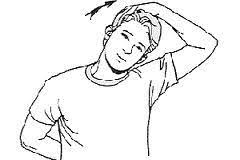
- This is a good method to stretch the trapezius muscle.
- How to do it – Took a sitting or standing position. Place the ipsilateral hand on the back & touch the other side of the back.
- Now flex the head on another side. If you want to stretch on the right side then flex the head on the left side.
- When you felt stretched then stop there. Hold that position for 30 secs and then do it on the other side.
- Do it two to three times.

Shoulder stretch:
- You are extended one arm outwards in front of you.
- With the other arm, pull the elbow joint of the outstretched arm toward the chest.
- Hold this stretching position for about 30 secs.
- Repeat this stretching exercise ten times in one session & repeat this session three times per day.
Extended Child’s Pose on Fingertips stretch:
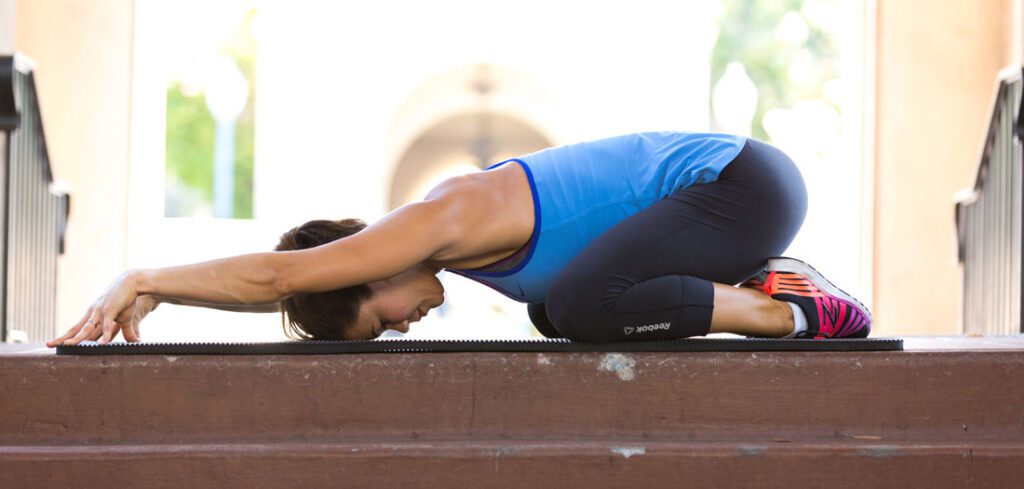
- The patient is Kneeling on the floor.
- Try to Touch the big toes together & the patient is sitting on the heels.
- Next, separate the knee joint about as wide as the hip joint.
- Then Bend the forward from the hip joint & walk the hands out as far in front of them as possible.
- With the arms extended palms are facing down then come up onto the fingertips as if the ball underneath the palms & melts the chest toward the floor.
Ear to shoulder stretch:
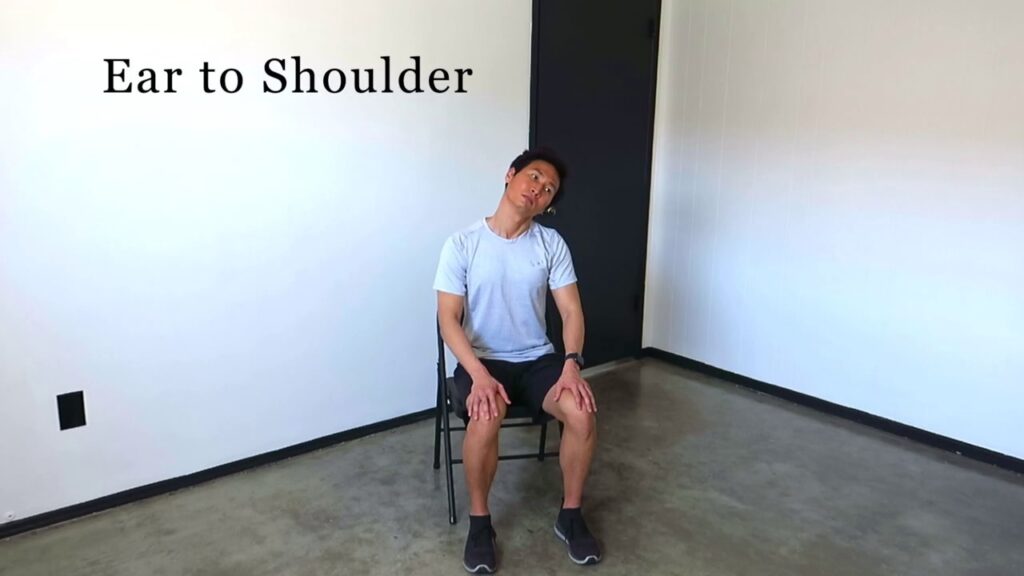
- You are sitting with a straight spine & tilt your head toward your right shoulder joint.
- Then Go as far as you can without straining & lifting your left shoulder joint.
- For Deepen the stretch by using your right hand to gently pull your head down.
- Hold this stretching position for 30 seconds.
- Repeat this stretching exercise 3 times in 1 session & 3 sessions per day.
Cross arm stretch:

- Start with your left arm across the front of your body at about chest height.
- For Support use your left arm with the elbow joint crease of your right arm.
- Then use your right hand to hold your left arm.
- Stretch out your shoulder joint & continue to face forward.
- Hold this stretching for 30 seconds.
- Repeat this stretching exercise 3 times in 1 session & 3 sessions per day.
Thread the needle stretch:
- This exercise starts with all fours with your hands directly under your shoulders & your knee joint underneath your hip joint.
- Lift your right hand & slowly bring it over to the left with your palm facing up.
- Rest your body on your right shoulder & turn your head to face to the left.
- Make sure you are not sinking onto your shoulder joint.
- Hold this exercise position for 30 seconds.
- Slowly release & come back to the original position.
- Repeat this stretching exercise 3 times in 1 session & 3 sessions per day.
Across-the-chest stretch:
- Start this exercise with your right arm across your chest.
- Place the arm in the crease of your left elbow joint & use your left hand to support your arm.
- Hold this stretching position for up to 1 minute.
- Then Repeat on the opposite side.
- Do this stretching each side 3–5 times.
- To deepen the stretch, lift your arm at shoulder height.
- Repeat this stretching 3 times in 1 session & 3 sessions per day.
Doorway trapezius stretch:
- You are standing in a doorway with your elbow joint & arms forming a 90-degree angle.
- Then Step your right foot forward as you press your palms into the sides of the door frame.
- Lean forward & engage your core muscle.
- Hold this stretching position for up to 30 seconds.
- Repeat the stretching with your left foot forward.
- Repeat this stretching exercise 3 times in 1 session & 3 sessions per day.

Pendulum stretch:
- You are standing with the feet hip-width apart.
- Lean forward & look at the ground.
- Then Place the right hand on a table & chair for support.
- Let the left arm hang down.
- then Swing the left arm gently in small circular motions & letting gravity do most of the work.
- Continue this stretching for 30 seconds to 1 minute.
- Then Change the direction of the motion.
- Repeat this stretching exercise 3 times in 1 session & 3 sessions per day.
Cross-body trapezius stretch:
- You are standing with the feet hip-width apart.
- Then try to Stretch the right arm out straight.
- Start the right arm across the body, so that place the hand points to the floor on the other side of the left leg.
- Bend the left arm at the elbow joint.
- Then Hook the left forearm under the right arm & for support use the right arm above the elbow joint.
- Use the left forearm to pull the right arm further in & across the body & try to stretch the back of the right shoulder.
- Hold this stretching for 30 seconds, then repeat this stretching on the other side.
- Repeat this stretching exercise 3 times in 1 session & 3 sessions per day.
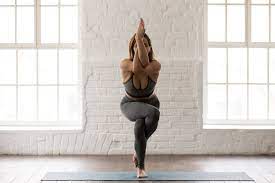
Eagle arm stretch:
- You are standing with your feet hip-width apart.
- During Inhale & lift the arms to the sides.
- During Exhale & swing the arms in toward the body.
- Then Allow the right arm to cross under the left arm.
- Cradle the left elbow joint in the crook of the right elbow joint.
- Start the palms together so that they reach for each other.
- When the palms are not touching & hold the backs of the hands together.
- Then take three or four deep breaths.
- Release the stretch & repeat it on the other side with the left arm crossed under the right.
- Repeat this stretching exercise 3 times in 1 session & 3 sessions per day.
Standing wall trap stretch:
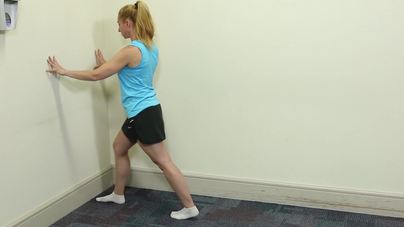
- First Place both hands on a wall from a 90-degree angle to your body.
- Then Walk your feet back till your arms are straight & bow, hinging forward at the hip joint.
- But take care of this thing Don’t push on the wall & don’t allow your arms to raise too high to avoid shoulder impingement.
- Must be Keep your shoulder blades set back & avoid scrunching your shoulder joint around your neck.
- Repeat this stretching exercise 3 times in 1 session & 3 sessions per day.
Across-the-chest stretch:
- Perform this stretching in a sitting or standing position.
- First, bring your right arm across your chest.
- Then place the arm in the crease of your left elbow joint.
- You are using your left hand to support your arm.
- Hold this stretching position for up to 1 minute & repeat on the opposite side.
- Do this stretching each side 3–5 times.
- To deepen the stretch, lift your arm at shoulder height.

Seated twist stretch:
- You are sitting in a chair with your ankle joint directly under your knee joint.
- Twist your upper body to the right & bringing the back of your left hand to your thigh.
- Then place your right hand down wherever you feel too comfortable.
- Hold this stretching position for up to 30 seconds & repeat on the left side.
- Do this stretching each side 3–5 times.
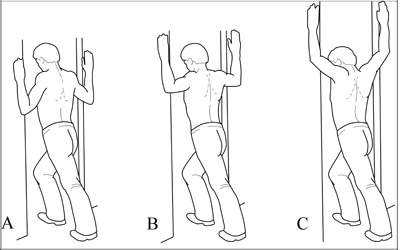
Doorway shoulder stretch:
- You are standing near a doorway with your elbow joint & arms forming a 90-degree angle.
- First, step your right foot forward as you press your palms into the sides of the door frame.
- Try to Lean forward & engage your core muscle.
- Hold this stretching position for up to 30 seconds.
- Then repeat the stretching with your left foot forward.
- Do this stretching exercise on each side 2–3 times.
Neck release stretch:
- This exercise is a gentle way to loosen tension in your neck & shoulder joints.
- Perform this stretching in a sitting or standing position.
- Then lower your chin toward your chest.
- You feel a stretch along the back of your neck.
- Try to gently tilt your head to the left side to stretch your right shoulder joint.
- Hold this stretching position for up to 1 minute & repeat on the opposite side.
- Do this stretching each side 3–5 times.
For to deepen in this stretch:
- First place 1 hand on your shoulder joint & 1 hand above your ear to gently guide the movement.
- Then lower your chin toward your chest.
- You feel a stretch along the back of your neck.
- Try to gently tilt your head to the left to stretch your right shoulder joint.
- Hold this stretching position for up to 1 minute & repeat on the opposite side.
- Do this stretching each side 3–5 times.
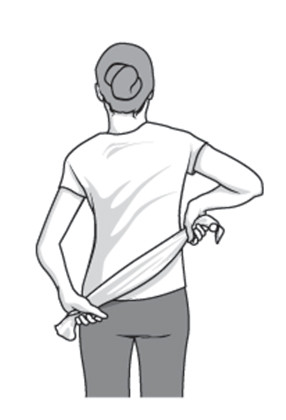
Towel stretch:
- First, hold one end of a three-foot-long towel behind your back & grab the opposite end with your other hand.
- You are holding the towel in a horizontal position.
- You must use your good arm to pull the affected arm upward to stretch it.
- You are also performing an advanced version of this exercise with your towel draped over your good shoulder joint.
- Then hold the bottom of the towel with the affected arm.
- Try to pull the arm toward the lower back with the use of the unaffected arm.
- Do this 10 to 20 times a day.
Bent Arm Scaption Plane Stretch:
- You are kneeling position next to an elevated surface.
- Then put one palm down on the surface with your elbow joint pointed up.
- Try to Roll the shoulder joint capsule in & out.
- You feel the best stretch in your pec during this stretching pose.
- Then move in & out of the stretch 10 times & hold this exercise for 15-30 seconds.
- Do the 1 set of 3 repetitions & 3 times per day.

Shoulder stretch:

- You are in a standing position.
- Try to raise your shoulder joint.
- Hold this exercise for 5 seconds.
- Then squeeze your shoulder blades back & together.
- Hold this exercise for 5 seconds.
- Try to pull your shoulder blades downward.
- Hold this exercise for 5 seconds.
- Relax & repeat this exercise 10 times.
Armpit stretch:
- Use the good arm, and lift with the affected arm about breast-high.
- Gently bend the knees and open up the armpit.
- Dee pend the knee bend slightly, gently stretch armpit.
- With each knee bend and stretch a little further, but not force it.
- Do this exercise 10 to 20 times each day.
Strengthening Exercise for Trapezius Palsy
Prone rowing exercise
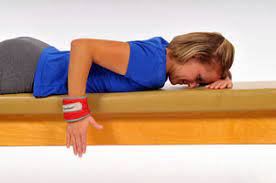
- lies prone on your bed with the arm hanging freely off of the side.
- While holding on the shoulder blade ‘set’,
- raise the arm against the floor while bending at the elbow.
- The elbow should be raised and the side of the body until the hands touch the lower ribs.
- Always return slowly to the start position.
- Perform 2 sets of 10-15 repetition
Angel Wings exercise
- Stand with your head, shoulders, upper back, and butt pressed close up to the wall. Your feet may need to be 10 – 12 inches from the wall.
- Keeping your knees slightly bent will reduce muscle pressure.
- With the reverses of your hands against the wall, stretch your arms straight above your head. you’re in the starting position.
- Squeeze your mid-back muscles as you slide your arms down close to your shoulders. Keep your body firmly pressed close to the wall.
- When elbows are just below shoulders, pause for just a sec, also slide your arms back to the starting position.
- Do 10 – 20 repetitions
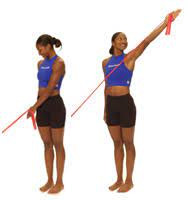
Shoulder Diagonals exercise
- The patient stands with theraband lower their opposite foot
- While grasping theraband, move shoulders up and down
- With your hand at your opposite hip, slowly raise it beyond
- your body, as if you’re pulling a blade
- Hold 3 seconds and repeat 10-15 times
Lateral Raises exercise
- Stand with the arm at your side with the elbow straight and the hands twisted so that the thumb’s face is ahead.
- put up the arm straight out to the side, palm downward, until the hands reach the shoulder position.
- Do not put up the hands forward than the shoulder. Pause and slowly down the arm.
- Perform 3 sets of 10-15 repetitions. for progression do this exercise with a dumbbell
Upright row exercise
- This is a common exercise for strengthening the trapezius. You can also try this exercise with dumbbells or a therabend in your hands.
- Stand up straight.
- With your fists held, pull up your fists as high as you can while bending your elbows, keeping your hands close to the front of your body. Hold for a count of ten.
- Release your arms back into a relaxed position, fists still hold
- Reprise 20 times.
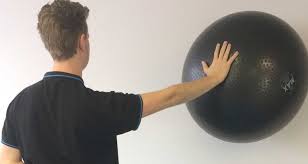
Physioball Scapular Exercises
- Stand with hand placed on physio ball beside a wall
- Bring shoulders up and down
- Slowly rotate your hand up and down over the ball
- Maintain shoulders up and down. repeat 15 to20 times
Horizontal Rows exercise
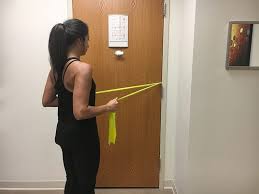
- Attach theraband around a stable object, like a pole
- The patient can either kneel or stand,
- Grasp both ends of the theraband, Bring shoulders up and down
- Slowly pull your elbows up, squeezing your shoulder blades together
- Hold 3 seconds and repeat 10-15 time

Wall Push-ups exercise
- Stand facing a wall.
- Place your hands on a wall, slightly wider than shoulder-width apart.
- Gently bend your body to the wall while squeezing your shoulder blades together, repeat the 10-15 time

Push up exercise
- lying face down on the floor, positioning your hands slightly wider than your shoulders.
- Don’t lock out the elbows; keep them slightly bent.
- your legs should be straight back and balanced by your hands and toes. raise your body off the floor and back to starting position,
- 10-12 times.
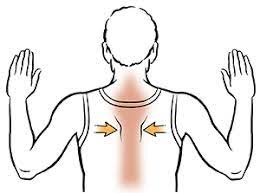
Shoulder blade squeeze exercise
- You are Standing up straight.
- Bring the elbow joint back & inward.
- Pulling the shoulder joint blades down & back.
- Then Return to the starting position.
- Repeat this exercise 10 times in 1 session & repeat this session 3 times per day.
Arm circles exercise
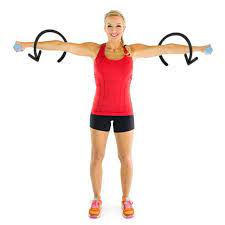
- You are standing upright with your arms are feet shoulder-width apart & your arms straight down your sides.
- Then Move your arms around in big circles going forward.
- Must Be sure to keep your arms straight.
- After several reps, switch – to the opposite direction so that you move your arms in a circle going backward.
- Repeat this exercise 10 times in 1 session & repeat this session 3 times per day.
Plank exercise
- You are lying on the floor facing down, with your elbow joint bent.
- Then Tighten your abdominal muscles as you lift the hip & knee joints off the floor.
- Then Hold this position for 30 seconds & return to starting position.
- Repeat this exercise 10 times in 1 session & repeat this session 3 times per day.
Shoulder raises exercise
- You are standing or sitting position.
- This exercise starts with your arms by your side & a straight back.
- Then slowly lift your shoulder joint toward your ears.
- Hold this exercise for 10 seconds & return to the slowly starting position.
- Repeat this exercise 10 times in 1 session & 3 sessions per day.

Shoulder rolls exercise
- First Maintain good posture in the standing or sitting position.
- Then Roll your shoulders joint up, back & down.
- Do this exercise movement 10 times.
- Then roll your shoulder joint up, forward & down 10 times.
- Repeat this exercise 10 times in 1 session & 3 sessions per day.
Standing arm swings exercise
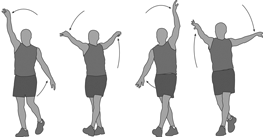
- You are standing with your arms by your side & your palms facing your body.
- Then Swing your arms forward to bring your arms as high up as they go without raising your shoulders joint.
- Lower the arms back down & bring them as far back as you can.
- Keep the rest of your body still.
- Continue this movement for 1 minute.
- Repeat this exercise 10 times in 1 session & 3 sessions per day.
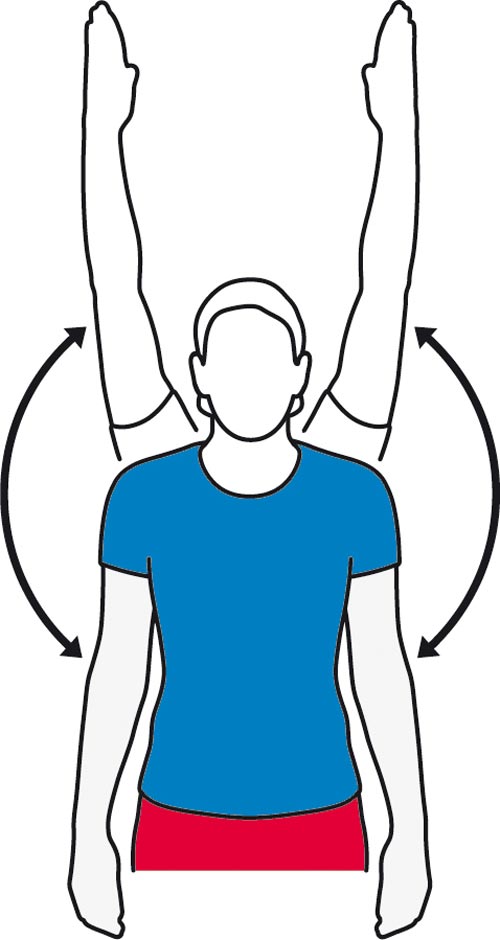
Standing arm lifts exercise
- First Make fists with your hands & bring them in front of your hip joint.
- Then do the Inhale as you lift your arms overhead so that your hands come together above your head.
- After that Lower back down to the original position.
- Repeat this exercise 10 times in 1 session & 3 sessions per day.
Wide-legged standing forward bend exercise
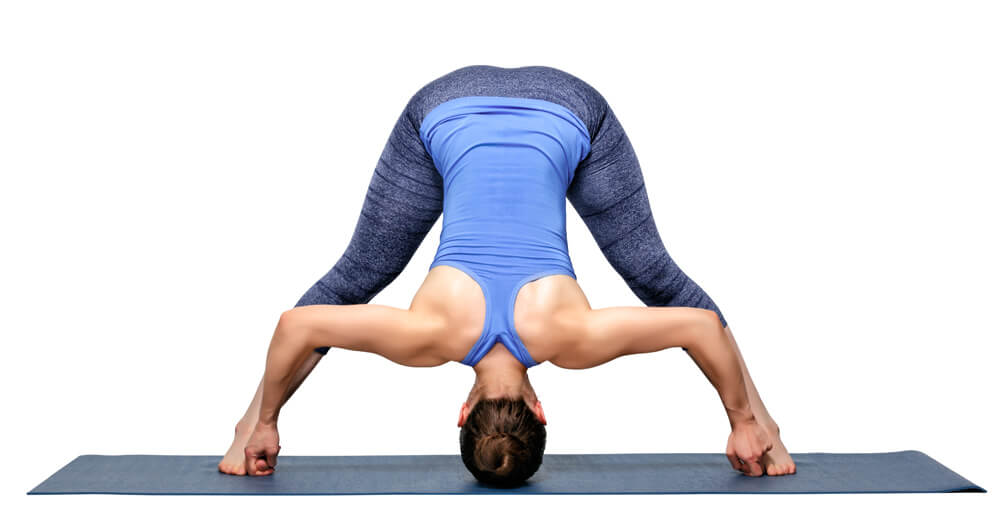
- You are standing with your feet wider than hip distance with your toes facing forward.
- Then Interlace your hands behind your back & open your chest.
- Engage your leg muscles & must keep a slight bend in your knee joint.
- Hinge at the hip joint to fold forward & bringing your arms over your head toward the floor.
- Then Allow your head to hang down & tuck your chin in slightly to your chest.
- Remain in this pose for up to 1 minute.
- Repeat this exercise 10 times in 1 session & 3 sessions per day.

Cat cow pose exercise
- First Place your hands underneath your shoulder joint & your knee joint underneath your hip joint.
- During inhale fill your belly with air & let it sink as you look up.
- During Exhale as you engage your abdominal muscle.
- Then try to tuck your chin into your chest & around your spine.
- Continue to do this movement for a few minutes & must focus special attention on your shoulder joint.
- Repeat this exercise 10 times in 1 session & 3 sessions per day.
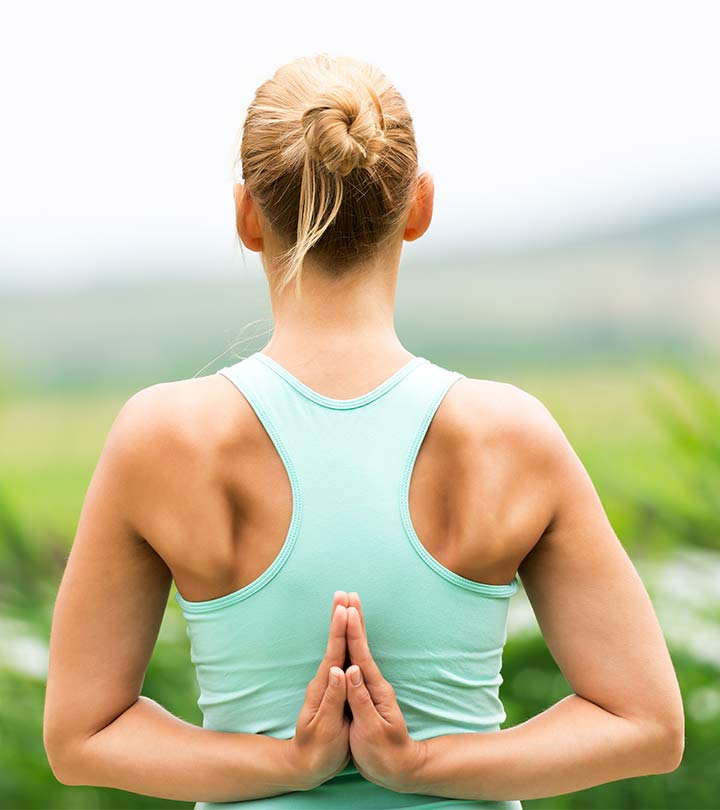
Reverse prayer pose exercise
- You are performing this pose in the sitting, standing position & tree pose.
- Then start this exercise with your hands behind your back with the backs of your hands facing each other & your fingers facing down.
- From this position flip your hands in the other direction so that your fingers are facing up.
- Then turn your palms to face each other.
- Press your palms together & draw your elbow joint slightly back & open your chest.
- Must Keep your spine straight.
- Then Hold this pose for 10 seconds.
- Repeat this exercise 10 times in 1 session & 3 sessions per day.
Cow face pose exercise
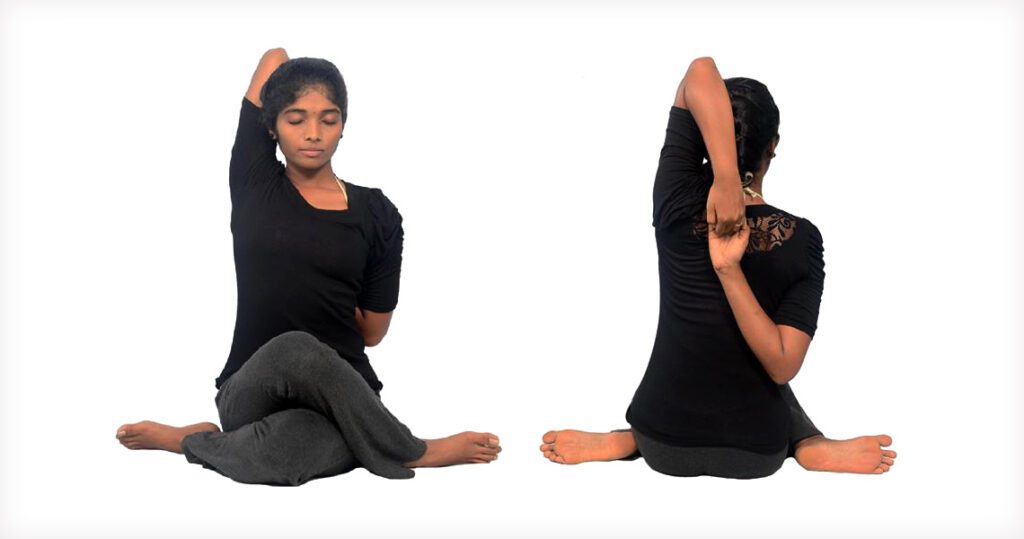
- Start this exercise in the sitting position & take to your left elbow joint up to the side of your head with your hand facing down your spine.
- With the help of your right hand draw your left elbow joint over to the right as your hand moves further down your spine.
- When you feel comfortable you can also bend your right arm & bring your right hand up to clasp your left hand.
- Hold the pose for 1 minute.
- Repeat this exercise 10 times in 1 session & 3 sessions per day.
Eagle arms spinal rolls exercise
- In the sitting position, extend your arms out to the sides.
- Cross your elbows joint in front of your body with place your right arm on top.
- Then Bend your elbow joint & placing the backs of your forearms & hands together.
- Try to reach your right hand around to bring your palms together.
- Hold this position for 30 seconds.
- During the exhale, roll your spine as your draw your elbow joint in toward your chest.
- During the inhale, open your chest & lift your arms.
- Then Continue this movement for 1 minute.
- Repeat this exercise 10 times in 1 session & 3 sessions per day.
Cross-body arm swings exercise
- You are standing with the feet hip-width apart.
- During Inhale lift the arms out to the sides & squeezing the shoulder blades together.
- During Exhale gently bring the arms in toward each other.
- Try to Cross the right arm under the left must keep both arms straight.
- During the Inhale & swing the arms back out to the sides & squeezing the shoulder blades together.
- During the Exhale & gently swing the arms in toward each other again.
- Cross the left arm under the right & must keep both arms straight.
- Repeat this exercise 10 times in 1 session & 3 sessions per day.
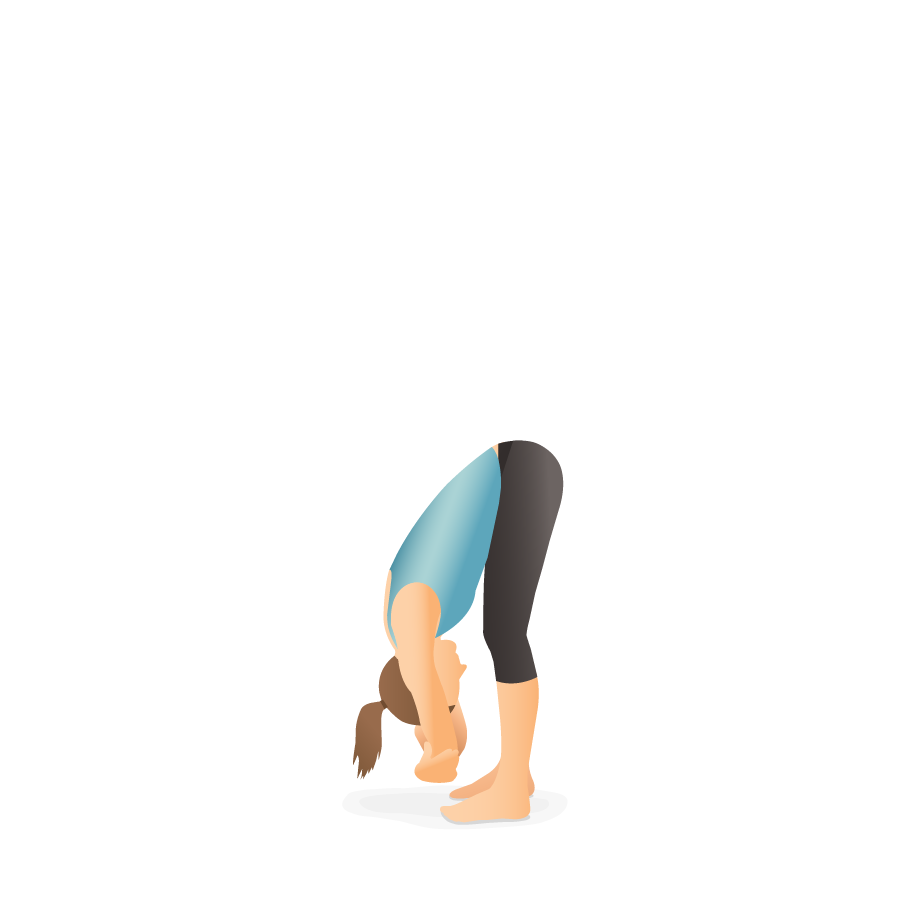
Shoulder rotation exercise
- With your back to a wall allows your shoulder blades to rest in a neutral position & bring both elbow joints out to 90 degrees.
- Then Without moving your elbow joint & turn your right arm upward, so that the back of your right-hand touches the wall & your left arm downward, so that your left palm is touch the wall.
- Then Slowly switch for about 30 seconds & trying to must keep your arms at 90 degrees.
- Repeat this exercise 10 times in 1 session & 3 sessions per day.
Ragdoll Pose exercise
- It is a forward-bend yoga pose which is help to release tension in the shoulder joint.
- You are in a Standing position with the feet hip-width apart.
- Bend the knee joint slightly.
- Bend forward & try to touch the toes.
- Must be Keep the stomach against the bent knee joint to support the lower back.
- Then Place each hand on the elbow joint of the opposite arm.
- Try to crown the head should point toward the floor.
- Let the head hang heavily & releasing tension in the neck & shoulder joints.
- Hold this pose for 1 minute.
- Repeat this exercise 10 times in 1 session & 3 sessions per day.
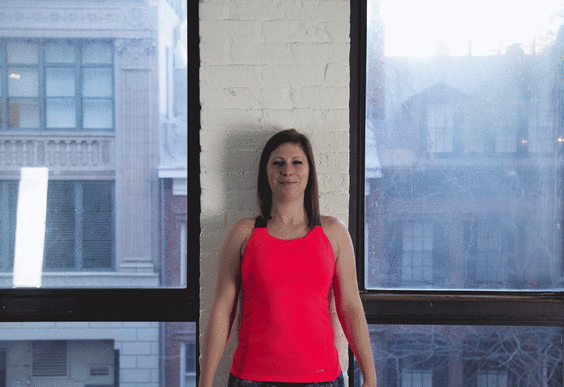
T, Y & I movements
- Start this exercise With your back to a wall & stand with your palms facing out.
- Then slowly bring your arms up to make a T shape & must be keeping your arms & back in contact with the wall.
- After that Continue to bring your arms up to make a Y shape, then do the I shape & try to touch your thumbs overhead.
- But must be kept focused on your shoulder blades flat against the wall.
- Repeat this movement 10 times in every shape & 3 sessions per day.
Pendulum exercise:
- The patient is in a standing position beside a table with the hand of the unaffected shoulder on the table & feet are slightly wider than shoulder-width apart.
- Then Bend the hip joint approximately to 75 to 90 degrees & let the affected arm hang down toward the floor.
- Shift the weight from side to side, letting the arms swing freely from side to side.
- Shift the weight forward & backward, letting the arms swing freely front to back.
- Once they feel comfortable with these movements, move the body so that the arm swings in a circle.
- Must be Keep the circle small, less than 8 inches.
- Continue for 30 seconds.
- Every day, increase the time to 3 to 5 minutes.
- Repeat this exercise 10 times per day.
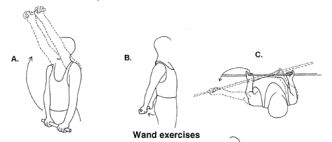
Wand exercise:
- This exercise is helpful to you for increasing ROM exercise.
- The patient is holding the wand with the help of both hands.
- Then perform the shoulder & elbow joint movement.
- Shoulder flexion, abduction, adduction, external & internal rotation & elbow flexion, and extension movement perform with the wand.
- Every exercise does the 2–3 times per day.
Lateral raises:
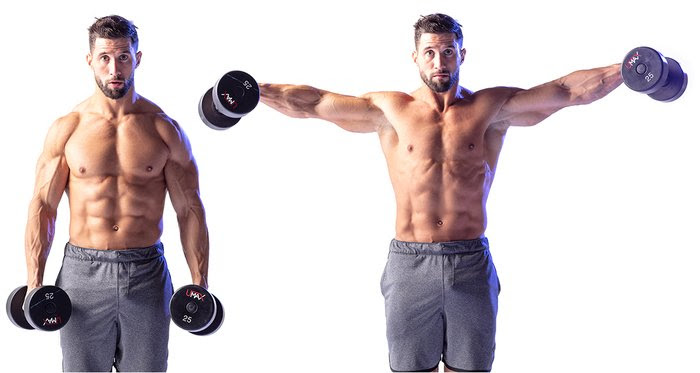
- First, hold a pair of light dumbbells for this exercise.
- You are standing with the feet slightly wider than the hip joint width apart.
- Try to raise the weights to the sides till are at shoulder level.
- Must be remembered to engage the core muscles & slowly lower the weights down to the sides.
- Repeat this exercise for 2 sets, in every set consisting of 12–15 reps & 3 to 4 times per week.
Bent-Over Horizontal Abduction:
- You are lying on your stomach means in a prone position on a table & bed with your injured arm hanging over the side.
- Must keep your arm straight & slowly raise it to eye level.
- Then slowly lower it back to the starting position & repeat this exercise.
- Do this exercise 2–3 times per day.
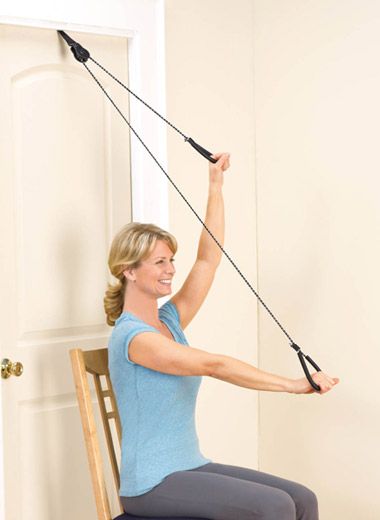
Pully exercise:
- For the shoulder active Assisted Exercise does the pully exercise.
- First, hold a rope–pully on both hands then perform the movement of the shoulder.
- Flexion,abduction,external & internal rotation.
- This exercise is performed 10 times in 1 session & 3 sessions per day.
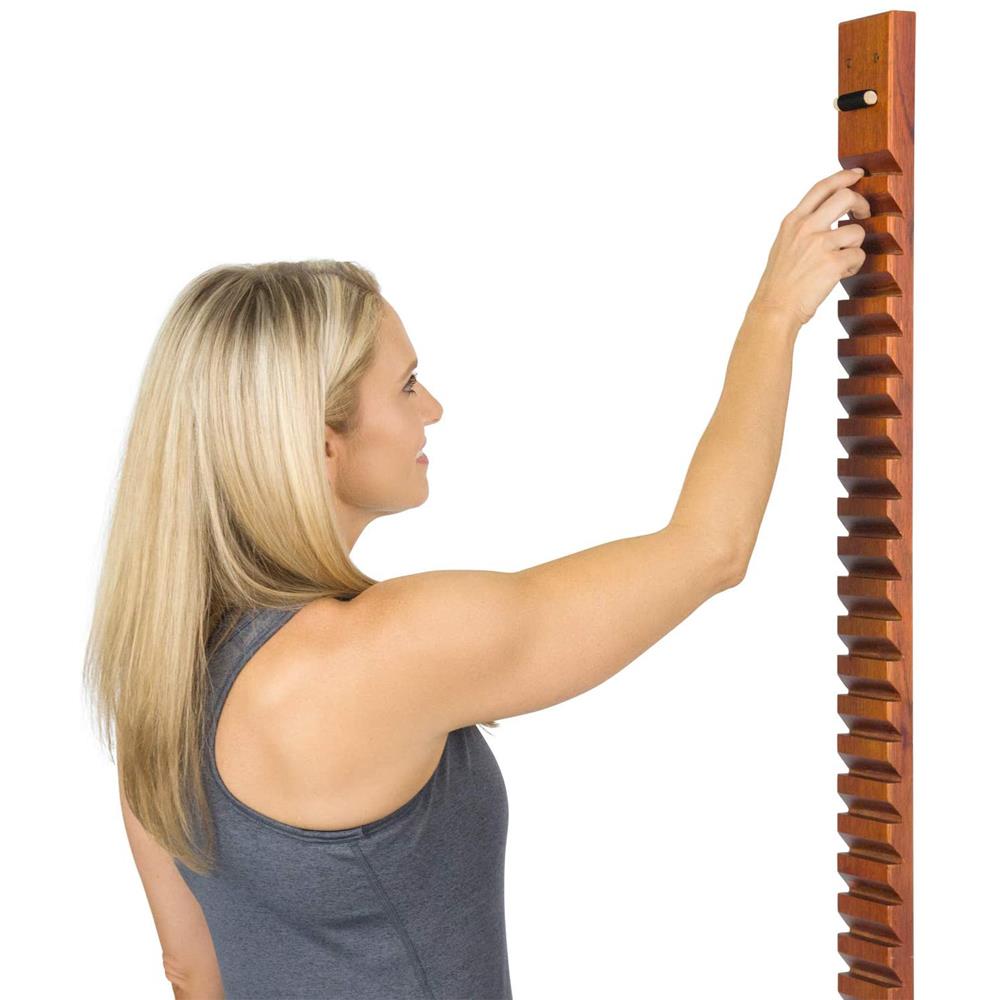
Finger ladder Exercises:
- The patient is in a standing position & facing a ladder that is hanging over a wall.
- Ask them to patient place the affected hands on the ladder at a low level.
- Then slowly start an upward climb on the finger ladder till it reached the top & slowly down back to the starting.
- This exercise is performed 10 times in 1 session & 3 sessions per day.

Thread the needle:
- Start this exercise on your hands & knees.
- First, lift your right hand toward the ceiling with your palm facing away from your body.
- Then lower your arm to bring the arm under your chest & over to the left side of your body with your palm facing up.
- It activates your right shoulder joint & arm to avoid collapsing into this area.
- Must keep your left hand on the floor for support.
- Then lift the arm toward the ceiling & bring the arm around to the inside of your right thigh.
- Hold this exercise position for up to 30 seconds & relax in a Child’s Pose.
- Then repeat this stretching exercise on the left side.
- Do this exercise 2–3 times per day.
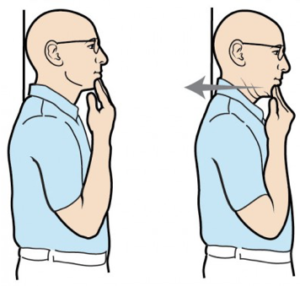
Chin tuck Exercise:
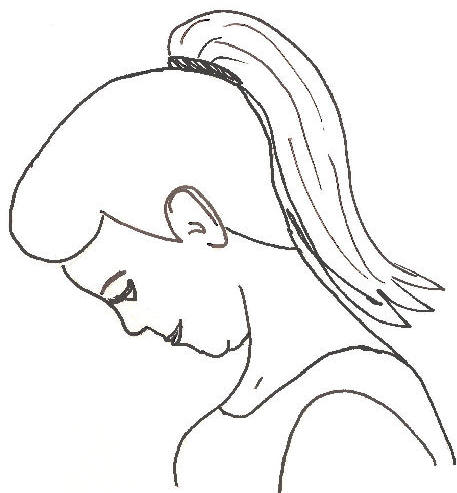
- Sit straight and look straight ahead with the ears directly over the shoulders.
- Put a finger on the chin.
- Without moving the finger, pull the chin and head straight backward until a good stretch is felt at the base of the head and top of the neck.
- Hold for 5 secs if possible.
Neck flexion Exercise (Neck tilt)
- In Relax sitting position flex your head down to rest your chin on your chest (Flex the neck fully).
- Gently tense your neck muscles and hold for 4 to 8 seconds.
- Return to a neutral position and repeat 10 times.
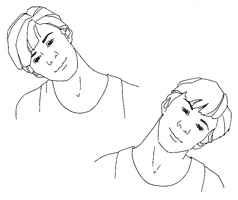
Neck flexion Exercise (side to side)
- Flex your head down towards your shoulder, and try to touch your shoulder with your ear (Without elevating your shoulder).
- Gently tense your neck muscles and hold for 8 seconds.
- Return your head to a neutral position and repeat in the opposite direction.
- Repeat 10 times on both sides.
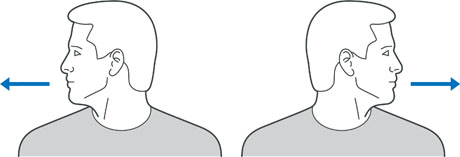
Neck Rotation exercise
- Rotate your head towards one side, keeping your chin at the same height and moving within comfortable limits.
- Gently stretch your neck muscles and hold for 8 seconds.
- Return your head to the neutral position and repeat in the opposite direction.
- Repeat 10 times on both sides.
Prone Cobra Exercise
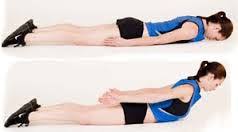
- This workout is done lying face down on the ground & uses gravity as resistance in the reinforcing process.
- Lying face down, put the forehead on a rolled-up hand towel for comfort.
- Place the arms at the side, palms downwards on the ground.
- Place the tongue on the roof of the mouth
- Pinch the shoulder blades together & lift the hands off the ground.
- Roll the elbows in, palms out, & thumbs upward.
- Gently lift the forehead about an inch off the towel keeping the eyes looking straight at the ground
- Hold the position for 10 secs.
- Perform 10 repetitions.
The isometric neck exercise
The isometric neck exercise that you can do while sitting, standing, or lying on your back:
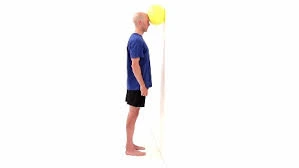
Isometric neck exercise in standing position:
- For this exercise, you require a medium size ball or you have to stand nearer to the wall side.
Neck flexion
- You have to stand straight with an erect posture, while the forehead is resting on a ball against the wall. By the forehead, you have to smoothly press the ball nearer to the wall.
- Maintain this position for 5 to 10 secs.
- The back should be straight or extended during the whole exercise.
Neck extension
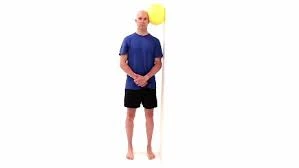
- You have to stand straight with an erect or upright posture, with the back of the head resting on a ball opposite the wall. By the head, you have to smoothly press the ball nearer to the wall.
- Maintain this position for 5 to 10 secs.
- The back should be in an upright position during the whole movement.
Neck Side flexion
- You have to stand straight with an erect or an upright posture, with the left side of the headrest on a ball opposite the wall.
- Slowly press the ball by the left side of the head nearer the wall.
- Maintain this position for 5 to 10 secs.
- The back should be in an upright position during the whole movement. Repeat this on another side also.
Isometric neck exercise in the Sitting position:
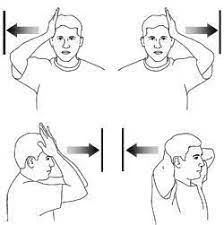
- In a sitting position for neck isometric exercise, you will need either a chair or a table. while you have to sit with an erect posture in a chair. In this position, you will do all neck motions which are explained under, or if you want to do this exercise standing then you have to stand with the hip or the shoulder-width apart with the torso extended.
Neck flexion
- Put the hand on the forehead then slightly push the neck in a forward direction, the hand remains in the same position you give light pressure opposite the movements like pushing the beside.
- Hold this for 5 to 10 secs.
- The back should be in an upright position during the whole movement.
Neck extension
- Put the hand on the back of the head then gently push the neck in the backward direction, the hand should be in the same position, just give little pressure opposite the movements like pushing to the forward side.
- Hold this for 5 to 10 secs.
- The back should be in an upright position during the whole movement.
Neck Side flexion
- Put the hand left side of the head with the head straight or the chin in a neutral position, now bring the head towards the left side shoulder by gently pushing the hand by the head.
- Hold this for 5 to 10 secs.
- The back should be in an upright position during the whole movement.
- Repeat this for right-side neck flexion.
Neck Rotation
- Put the right hand on the left side of the chin or turn the head slightly nearer the left side by gently pushing the hand and trying to look back at you.
- The back should be in an upright position during the whole movement.
- Hold this for 5 to 10 secs.
- Perform this exercise on the right side by taking assistance from the left hand.
Isometric neck exercise in Supine lying position:
- For this exercise, you have to lie down on the back over a plinth or the mattress by using a small pillow or a rolled towel below the head, the hand by the side.
Neck flexion
- For this exercise you have to lie on the tummy pillow used under the head you have to push the pillow by the forehead or hold it for 5 to 10 secs.
Neck extension
- For this exercise, you have to lie down on the back over a plinth or a mattress by using a small pillow or a rolled towel below the head, the hand by the side.
- Push the pillow by the back of the head, or hold this for 5 to 10 secs.
Neck side flexion
- For this exercise, you have to lie on any side right or left side.
- Take a pillow below the head, now gently push the pillow by you nearer to the plinth.
- Hold this for 5 to 10 secs.
- Perform this on the right side.
Making lifestyle changes for pain relief
Sit up or stand up straight during the day.
- As you do, bring the shoulders down, and make sure the head is back. Imagine a string lifting the body, keeping you upright.
- Correct posture will help take off some of the strain from the trapezius muscles.
- Also, avoid activities that make you hunch on 1 and both shoulders, like holding a phone on 1 shoulder.
Sleep on the side to keep the head straight.
- If you sleep on the stomach, the head is always turned to 1 side, putting strain on the trapezius muscles. Try to sleep on the side, instead, which doesn’t turn the head to the side.
- You can also sleep on the back but only if the head doesn’t fall to 1 side or the other.
Skip carrying a heavy backpack and shoulder sling or shoulder bag.
- A heavy bag can strain your trapezius muscles. Instead, try a belt and purse, or only carry what you absolutely must.
- If you are required to carry a bigger bag, then try a rolling briefcase.
- If you must carry a shoulder bag, make sure you switch off the shoulders.
- Similarly, more tight bra straps can also gave excess pressure on the trapezius muscles.
- Make sure the bra should get fitted properly.
Elevate the electronics so you don’t slump over.
- Slumping over can cause soreness in the trapezius muscles, and if you’re on a smartphone and computer, you may find yourself slumping a lot. To fix the issue, move the device so it is at eye level. That may mean that you are holding the smartphone up in front of you, but that is better than slumping over.
- If you work at a desk, try getting an elevated stand for the screen and laptop to bring it up to eye level or higher.
Adjust the keyboard or armrests to the correct height.
- Work in a chair with armrests, as the weight of the arms can put a strain on the muscles after a while. Also, make sure the keyboard is even with the arms when you’re sitting up straight with the elbows at a right angle. You should not be required to lift your arms up to type.
- If you need to lower the keyboard, try a keyboard shelf.
- Other exercises or training which is helpful to strengthen the trapezius muscle is:
- Strengthening or Improve Range:
- Muscle energy techniques for the trapezius
- Positional release technique for trapezius.
- Theraband resisted exercises.
- Upper body strengthening exercises.
Precautions While Doing Exercises
- Do not overdo the exercise.
- Wear light and proper clothes while doing exercise always.
- Keep your breathing normal.
- If you feel any discomfort while doing exercise, stop doing it and consult it your physiotherapist or doctor.
- Do not unnecessarily strain your neck muscles.
- Do not overstretch the muscles while doing neck exercises.
- Always begins neck exercise simply then and under the supervision of your physical therapist.
- Increase repetitions gradually.
Common Mistakes
- Be sure to breathe deeper as well as evenly while doing the stretch. Focus on inhaling as you reach into the stretch or exhale to deepen the extension. Hold each stretch for a few secs of breaths then relax a hold. Activate a stretch again during resuming deeper breathing.
The simple act of deep breathing may increase the effects of a stretch significantly. - Additionally, not relaxing the face, neck, as well as shoulder muscles is also a common mistake when doing cow face poses. Assist decreased head and neck pain by actively relaxing the facial as well as neck muscles. Remember to embark at the top relax the forehead, cheeks, mouth, chin, neck, and finally, shoulders. This mental exercise will ensure that the patient is not tense during the whole stretch.
Safety and Precautions
- If the patient experiences any pain, numbness, and even pinching during performing any of these stretches, stop and cut out of the stretch and exercise you are doing.
- Make sure to breathe deeper as well as evenly while also relaxing the neck, face, and shoulder muscles.
FAQs
What is Trapezius Palsy?
Trapezius palsy is a rare nerve condition in the shoulder that causes pain or weakness. It includes injury to the spinal accessory nerve at the neck and shoulder.
What are the Causes of Trapezius Palsy?
Damage to this nerve might be caused by:
A jerking injury of the arm
Trauma to the neck
A jerking injury of the neck
A result of surgery to the neckWhat are the Symptoms of Trapezius Palsy?
Signs and Symptoms of trapezius muscle injury might include:
Pain or discomfort, usually burning and the dull ache that is poorly localized, often in the back of the shoulder and shoulder blade
Heaviness and fatigue of the arm
Difficulty in raising the arm above shoulder level
Loss of power of the shoulder musclesWhat are the Preventive Measures for Trapezius Palsy?
The Preventive Measures for Trapezius Palsy are;
Appropriately warm up or stretch before practice or competition.
Maintain proper conditioning that includes shoulder flexibility, muscle strength, or endurance training.
Wear proper shoulder protective pads.Treatment for Trapezius Palsy
Treatment is aimed at reestablishment the function of the trapezius muscle. Physiotherapy treatment can include:
Electrotherapy
Stretching exercises
Strengthening exercises
The practice of functional movements

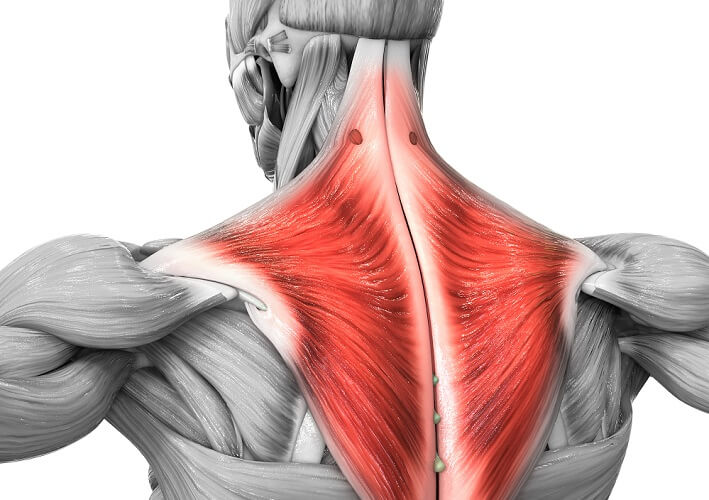

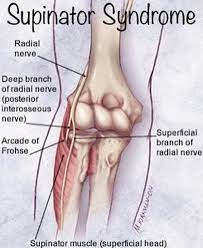
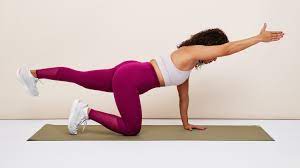
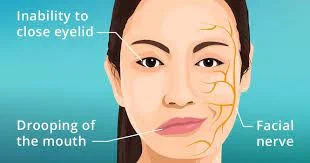


5 Comments